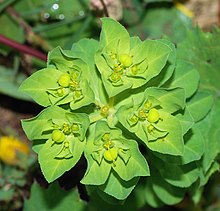
Euphorbia is a very large and diverse genus of flowering plants, commonly called spurge, in the family Euphorbiaceae. "Euphorbia" is sometimes used in ordinary English to collectively refer to all members of Euphorbiaceae, not just to members of the genus.

Euphorbia esula, commonly known as green spurge or leafy spurge, is a species of spurge native to central and southern Europe, and eastward through most of Asia north of the Himalaya to Korea and eastern Siberia. It can also be found in some parts of Alaska.

Euphorbia resinifera, the resin spurge, is a species of spurge native to Morocco, where it occurs on the slopes of the Atlas Mountains. The dried latex of the plant was used in ancient medicine. It contains resiniferatoxin, an extremely potent capsaicin analog tested as an analgesic since 1997.
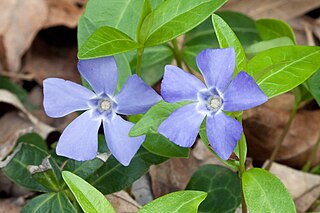
Vinca minor is a species of flowering plant in the dogbane family, native to central and southern Europe, from Portugal and France north to the Netherlands and the Baltic States, east to the Caucasus, and also southwestern Asia in Turkey. Other vernacular names used in cultivation include small periwinkle, common periwinkle, and sometimes in the United States, myrtle or creeping myrtle.

Euphorbia lathyris, the caper spurge or paper spurge, is a species of spurge native to southern Europe, northwest Africa, and eastward through southwest Asia to western China.
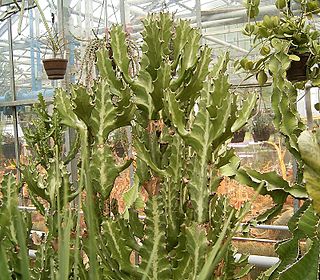
Euphorbia lactea is a species of spurge native to tropical Asia, mainly in India.
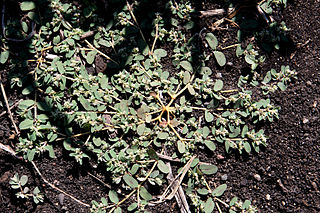
Euphorbia maculata, known as spotted spurge, prostrate spurge, milk purslane, or spotted sandmat, is a fast-growing annual plant in the family Euphorbiaceae. While it is native to North America, where it is a common garden and lawn weed in the United States, it has become a common introduced species throughout the world, including Europe, Japan, Korea, Australia, and New Zealand.

Euphorbia corollata is an herbaceous perennial plant in the family Euphorbiaceae that is native to North America. A common name for the species is flowering spurge. It has a milky sap that can cause skin and eye irritation in some people. It grows up to 1 m (3 ft) tall, with smooth stems and light green leaves arranged alternately or in whorls. Leaves are about 10 mm wide and 75 mm (3 in) long. Each stem terminates in a panicle 20 to 25 mm across. Flowers are about 6 mm across and consist of one pistillate and several staminate flowers surrounded by five white bracts - not petals but formed from the involucre at the base of the flowers. Flowering spurge blooms from June to September.

Euphorbia eriantha is a species of spurge known by the common name beetle spurge. It is native to the deserts of northern Mexico and the southwestern United States from California to Texas. This is an annual herb reaching anywhere from 15 to 50 centimeters in height. The leaves are long, narrow, and pointed, sometimes with sparse hairs, and 2 to 7 centimeters long. The foliage may be dark in color, from greenish to purplish or reddish. The inflorescence appears at the tip of the branch and contains staminate or pistillate flowers which are just a few millimeters wide. The fruit is an oblong, hairy capsule half a centimeter long, with gray and black mottling. It contains bumpy white or gray seeds.

Euphorbia misera is a semi-succulent shrub in the genus Euphorbia commonly known as the cliff spurge or coast spurge. A drought-deciduous shrub, it is typically found as a gnarled, straggly plant occupying seashore bluffs, hills and deserts. Like other members of its genus, it has a milky sap, which can be found exuding out of the light gray bark when damaged. The alternately-arranged leaves are round and folded in the middle, with small hairs on them. The "flowers" can be found blooming year-round, and are colored maroon or yellow in the center with 5 white to light-yellow petal-like appendages attached outside. This species is native to the Baja California peninsula and Sonora in Mexico, and the coast of southern California in the United States, where it is a rare species. It is threatened in some localities by the development of its coastal habitat, which tends to be prime locations for high-end residential and commercial developments.
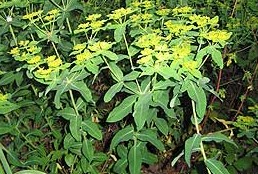
Euphorbia oblongata is a species of spurge known by the common names Balkan spurge, eggleaf spurge and oblong spurge. It is native to Eurasia but can be found elsewhere as a weedy introduced species. This is a hairy perennial herb growing to maximum heights of just over half a metre. It has oval-shaped or narrow leaves with finely toothed edges which are 4 to 6 centimetres long. The foliage is green to yellow-green. The inflorescences hold tiny glandular flowers. The fruit is a spherical capsule about half a centimetre long which contains smooth brown seeds.
Euphorbia lurida is a species of spurge known by the common name woodland spurge. It is native to the southwestern United States from California to Utah, where it can be found in a number of habitats. This is a common perennial herb usually not exceeding half a meter in height. It has small oval green leaves all along its erect stems. The inflorescences at the tips of the stems have tiny glandular flowers with ridged or toothed tips. The fruit is a rounded capsule a few millimeters wide containing tiny gray seeds.
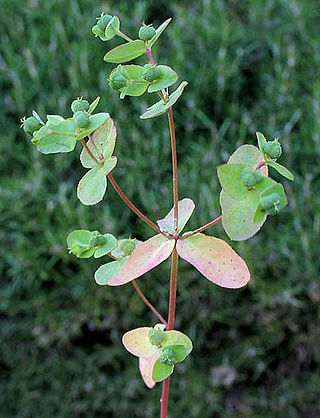
Euphorbia spathulata is a species of spurge known by the common names warty spurge and roughpod spurge.

Euphorbia marginata is a small annual in the spurge family.

Euphorbia nutans is a species of Euphorbia known by the common names eyebane and nodding spurge. It is native to much of the United States, Eastern Canada, Mexico, Central America, the Caribbean, and Venezuela.

Euphorbia prostrata is a species of spurge known by the common name prostrate spurge or prostrate sandmat.
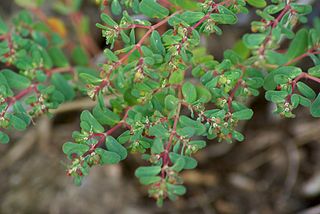
Euphorbia serpyllifolia is a species of euphorb known by the common names thymeleaf sandmat or thyme-leafed spurge. It is native to a large part of North America from Canada to Mexico, where it is a common member of the flora in many types of habitat. This is an annual herb growing as a prostrate mat or taking a somewhat erect form. The oblong leaves are up to about 1.5 centimeters long, sometimes hairy and finely toothed along the edges. The tiny inflorescence is a cyathium about a millimeter wide. It bears scalloped white petal-like appendages arranged around the actual flowers. At the center are several male flowers and one female flower, which develops into a lobed, oval fruit up to 2 millimeters wide. This plant had a number of traditional medicinal uses for many Native American groups.

Euphorbia schizoloba is a species of euphorb known by the common name Mojave spurge. It is native to the southwestern United States, where it grows in desert hills and mountains. It is a perennial herb producing upright stems up to 40 centimeters tall, sometimes with coats of sparse hairs. The stems are lined with alternately arranged leaves which are oval with pointed tips and measure up to 2 centimeters in length. The inflorescence is a cyathium with bell-shaped bracts surrounding four tiny glands with flat, fringed appendages. At the center of this arrangement are several staminate flowers and one long pistillate flower.

Euphorbia rigida, the gopher spurge or upright myrtle spurge, is a species of flowering plant in the spurge family Euphorbiaceae, native to southern Europe and southwest Asia. Growing to 50 cm (20 in) tall and broad, it is a bushy evergreen perennial with somewhat fleshy leaves arranged in a spiral, bearing bunches of bright yellow flowers in late Spring.
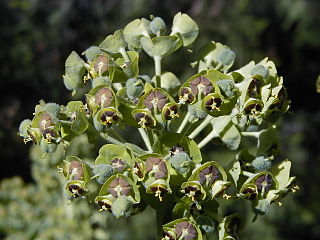
Euphorbia characias, the Mediterranean spurge or Albanian spurge, is a species of flowering plant in the family Euphorbiaceae typical of the Mediterranean vegetation. It is an upright, compact evergreen shrub growing to 1.2 m tall and wide.
